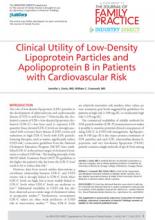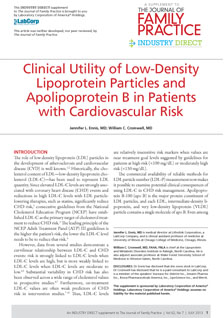Article Type
Changed
Tue, 05/21/2019 - 12:18
Display Headline
Clinical Utility of Low-Density Lipoprotein Particles and Apolipoprotein B in Patients with Cardiovascular Risk
Sponsor
This INDUSTRY DIRECT supplement to The Journal of Family Practice is brought to…
Article PDF
Issue
The Journal of Family Practice - 62(7)
Publications
Topics
Page Number
S1-S8
Sections
Article PDF
Article PDF
Sponsor
This INDUSTRY DIRECT supplement to The Journal of Family Practice is brought to…
Sponsor
This INDUSTRY DIRECT supplement to The Journal of Family Practice is brought to…
Issue
The Journal of Family Practice - 62(7)
Issue
The Journal of Family Practice - 62(7)
Page Number
S1-S8
Page Number
S1-S8
Publications
Publications
Topics
Article Type
Display Headline
Clinical Utility of Low-Density Lipoprotein Particles and Apolipoprotein B in Patients with Cardiovascular Risk
Display Headline
Clinical Utility of Low-Density Lipoprotein Particles and Apolipoprotein B in Patients with Cardiovascular Risk
Sections
Disallow All Ads
Alternative CME
Consolidated Pubs: Do Not Show Source Publication Logo
Use ProPublica
Article PDF Media
Document

